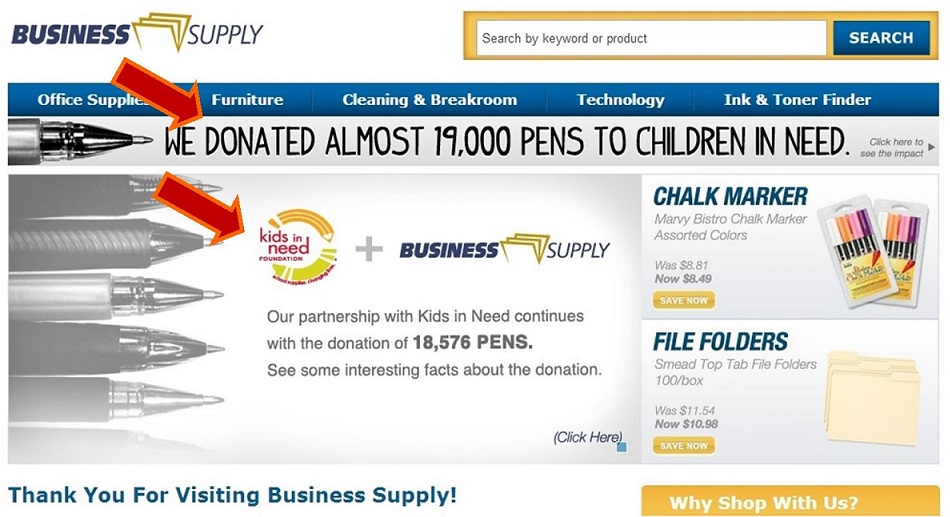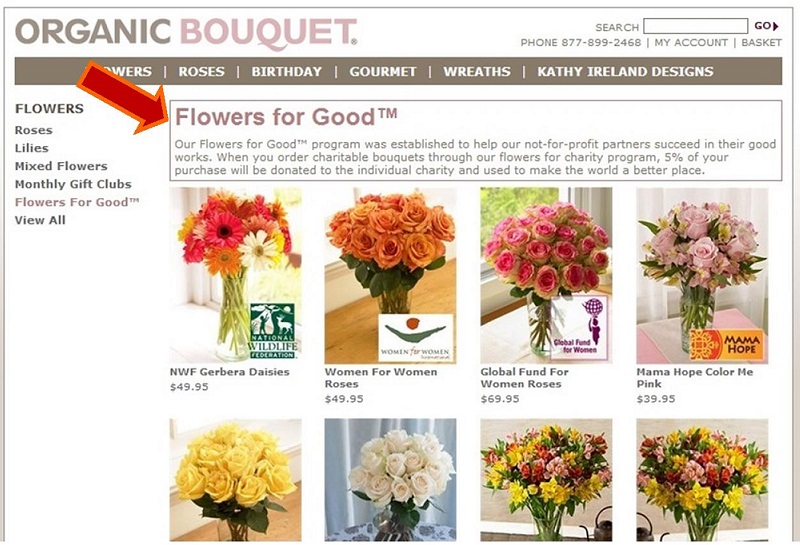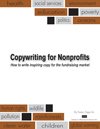Team up to get exposure to new audiences. To acquire more donors. To raise more funds.
 Who might you team up with? How about an e-retailer?
Who might you team up with? How about an e-retailer?
An article in InternetRetailer.com is on this very topic.
Here’s a statistic from the article taken from an October 2012 survey by Ask Your Target Market that’s worth noting:
56.3% of consumers say they’ve bought an item specifically
because the proceeds or
the brand support a cause
A few “partnerships” between e-retailers and charities were highlighted in the InternetRetailer article:
Business-Supply.com: For every order placed, they donate one unit of a type of school supply – crayons, markers, pencils, paper, scissors or glue – to the Kids In Need Foundation. The Foundation distributes the supplies to teachers around the country. Both the Foundation and the e-retailer promote the program.

Organic Bouquet: There’s a section of its website – Flowers for Good – where a portion of the proceeds (5%) from sales is donated to nonprofits. But for traffic sent to the e-retailer site directly from the nonprofit’s website … they donate up to 15% from the purchase of a bouquet.

If your nonprofit isn’t yet involved in cause marketing, then you may not know that retailers typically work with nonprofits in one of three ways:
1. Retailers commit to a set level of ongoing donations (e.g., Business-Supply.com)
2. Retailers agree to donate a portion of sales to a cause. This may be ongoing (e.g., Flowers for Good), or in support of a specific campaign or event.
3. On the rise is the model where retailers have charity as part of their business model from inception (e.g., Toms Shoes, Warby Parker, and Lush Cosmetics).
As the nonprofit, you may have an easier time lining up a cause marketing partnership with an e-retailer if you help them along. Here are my suggestions:
• Share the multiple benefits to the e-retailer such as acquiring more customers; and increased customer engagement, loyalty and awareness.
• Use third party credibility to strengthen your case. Share the article from InternetRetailer with the e-retailer. Be sure you study it thoroughly yourself first. (Link to article found at end of this post with “Resources.”)
• Charitable activities can influence the purchasing decisions of online shoppers. Read that statistic again – 56.3%
• Consumers are donors. Help your e-retailer partner show consumers how their purchase will help your cause. Help make the connection clear. Help the retailer with the messaging.
• You’ll need to do plenty of marketing and promoting – probably much more than the retailer does. This could include your website, social media, press releases, emails and direct mail.
Also remember that it’s equally important for the e-retailer to choose wisely which charity they work with. Just like you, they get the best results when the cause aligns with their products or brand positioning.
Look at it from the retailer’s perspective. Put yourself in their shoes. And please don’t fault them for “turning a profit” and wanting to know how they’ll increase sales (this is critical for their business) by supporting your cause and joining forces with you.
If you’re a small or mid-sized charity or foundation, you may have better success going after smaller e-retailers. Don’t focus on the mammoths such as Amazon.
Brainstorm.
For example: Many charities rely on aviation to perform their mission. What about an aircraft parts supply e-retailer?
Another example: Senior care facilities. Lots of retailers sell supplies online that are specifically for health care, senior care, etc.
Augment your fundraising by strategically partnering with an e-retailer. Done right, it’s a respectable way to prospect and diversify your acquisition of donors. And it can also increase loyalty. I firmly believe that nonprofits of ALL sizes and nearly all missions can find a company to partner with. And please remember that it has to be beneficial for both organizations. Be flexible.
Related posts:
Cause marketing example – US Airways & Keep America Beautiful (as part of press release writing tips: “How to get noticed…”)
‘Cause it makes good sense to team up
Cause Marketing and Nonprofit Infographics
Resources for this post:
Spread the Wealth – Some retailers are reaping returns by working hand-in-hand with nonprofit organizations, by InternetRetailer.com
Photo Credit: “Des Dibuix” via PhotoPin.com
